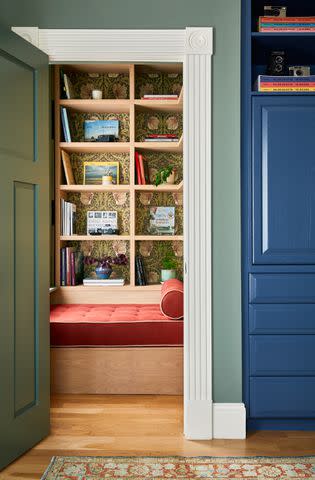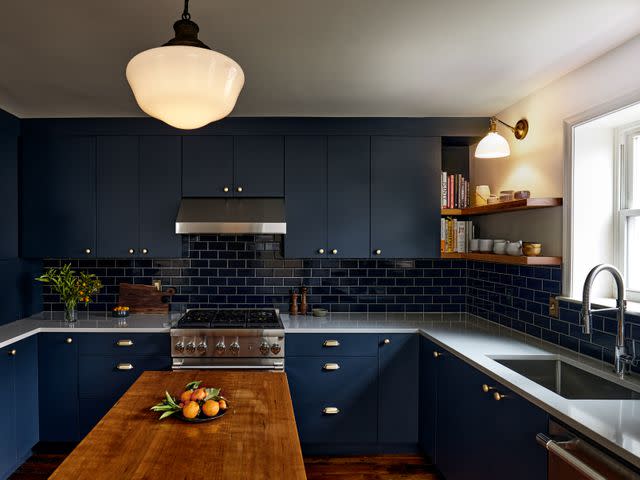9 Secrets Interior Designers Use to Make Small Rooms Look Bigger

Design: HouseMill Design / Photo: Sarah Natsumi Moore
For designers, figuring out clever ways to make small spaces seem larger can be quite the creative challenge. For example, in a compact powder bathroom, utilizing a floating vanity with under cabinet lighting and light wallpaper or paint is optimal.
"It'll keep the room feeling light and airy," says designer Alex Thies of Adelyn Charles Interiors.
Whether you are looking to maximize your whole home or a single room, check out these nine must-read tips from interior designers.
Capitalize on Natural Light

This former Holiday Inn in Los Angeles was redesigned as small apartments by Studio Sucio.
"Capitalize on natural light and let windows be uncovered," says designer Leslie Barrett. "If you must cover, employ the sparest of shades, like a roll-down mesh."
In this space, color blocking separates the ceiling from the walls and gives a foreground and background, plus a custom-designed bed with built-in storage and a desk focuses on function and saving square feet.
Get Crafty With Paint

British designer Hannah Drakeford knows that a little paint can go a long way.
"Sometimes a clever paint treatment can be all you need to make a space feel larger," she says.
The hallway in her apartment is long and narrow with no natural light, so to make the space feel longer and taller, she got painting.
"This may sound counterintuitive, as dark colors typically make rooms feel enclosed, but black plays with your perception of a space. It effectively just disppears, which in this case makes the room feel longer and the ceiling higher," Drakeford says.
Hang a Statement Mirror

Design: @natashanyanin / Instagram / Photo: Nathaniel Johnston
As someone who lives in a 350-square-foot Manhattan studio, writer and creative consultant Natasha Nyanin had to be intentional with how to make her home feel larger.
"Two of my go-to rules have to do with mirrors and drapery," she says. "Hanging a statement mirror in a space is an excellent opportunity to assert bold style but also has the added benefit of making a room feel more vast since it reflects light and creates the visual illusion of a more expansive space."
And when it comes to hanging curtains, she always opts to attach as close to the ceiling. "This draws the eye line upward and makes the ceiling feel higher," Nyanin says.
Choose Built-Ins

Design: Brooklinteriors / Photo: Sean Litchfield
"I love how built-ins maximize usable space while adding architectural detail to a room," says Alicia Hassen of Brooklinteriors. "There are endless ways to get creative with size, shape, and even the backdrop by using a textured or printed wallpaper."
This cozy and colorful reading nook shows off how to make a small room pop but also how to ensure crisp storage. From a functional perspective, she also loves built-ins as an addition to a built-in desk for books and paperwork.
Go for Dark Colors

Sometimes moody and dark can just be as space-opening as a light and airy palette.
"When I design for small spaces, I lean into the atmosphere of the room," says designer Emma Montgomery. "Oftentimes, a dark color on the walls can actually make the space feel bigger. For example, this kitchen was small and had poor light quality, so we leaned into the coziness of the room and designed midnight blue cabinets with matching tile. It made the wood floors pop, created a very rich color scheme, and made the space feel more expansive."
Choose Compact Furnishings

Design: HouseMill Design / Photo: Sarah Natsumi Moore
In order to keep a living room and kitchen from feeling too close to one another in this south Austin bungalow, interior designer Lauren Ramirez utilized two tips: keep large surfaces like walls and countertops white to help them feel more open and spacious, and purchase space-saving furnishings.
"We made sure to incorporate a narrow coffee table. By keeping the sitting area footprint long and lean, we were able to maintain a generous living area without the space feeling too cramped or too close to the island," Ramirez says.
Leave Walls Blank

@ekaterynagonchar / Instagram
Kateryna Gonchar lives in a 50-square-meter (538 square feet) apartment in Berlin and has learned a lot about how to best use her space.
"I tried not to overfill the rooms, leaving some empty places and blank walls," she says. "In small houses, it works very well to use large, roomy furniture as center pieces and then create situations around it. I strongly advise against ( having done it myself ) using small furniture that will instead go to occupy an unclear space without making sense of the room, plus it will not be able to hold what we inevitably need to store."
Create Zones

Native New Yorker and designer Jenny Davis knows a thing or two about small space living is her thing, learning make her home work for her growing family.
"Creating zones within a room can make it look and feel bigger, as long as it’s done right," she says. "Placing furniture perpendicular to or off the wall is a great way to do this. I’ve used this tactic in our kids’ bedroom where I floated a table in the back of the room to define and anchor the art area. And, in the living room, I use a toy hub to divide the kids’ play area and our living room, and it has an open back so it doesn’t minimize light or how far the eye can see.
Davis says that creating zones can help you make the most of your space, no matter the size, as well as making your home look and feel bigger.
Up the Scale

Design: Lily Spindle / Photo: Joe Atlas
For Lily Spindle co-founders and principal designers Rebecca Cox and Debra Vigna, making the most of a large wall can do wonders in a small space.
"We especially love integrating a large piece of art into the room in such a way that its energy and scale translates to and infuses the entirety of the room with a sense of spaciousness and grandeur," they say.
Read Next:6 Tricks Designers Always Use to Make a Room Look Expensive
